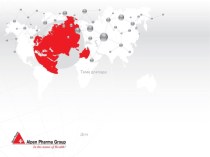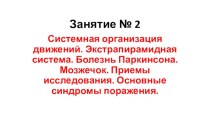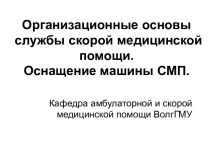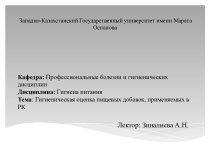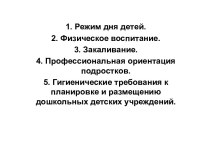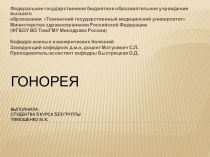- Главная
- Разное
- Бизнес и предпринимательство
- Образование
- Развлечения
- Государство
- Спорт
- Графика
- Культурология
- Еда и кулинария
- Лингвистика
- Религиоведение
- Черчение
- Физкультура
- ИЗО
- Психология
- Социология
- Английский язык
- Астрономия
- Алгебра
- Биология
- География
- Геометрия
- Детские презентации
- Информатика
- История
- Литература
- Маркетинг
- Математика
- Медицина
- Менеджмент
- Музыка
- МХК
- Немецкий язык
- ОБЖ
- Обществознание
- Окружающий мир
- Педагогика
- Русский язык
- Технология
- Физика
- Философия
- Химия
- Шаблоны, картинки для презентаций
- Экология
- Экономика
- Юриспруденция
Что такое findslide.org?
FindSlide.org - это сайт презентаций, докладов, шаблонов в формате PowerPoint.
Обратная связь
Email: Нажмите что бы посмотреть
Презентация на тему The Alimentary Tract
Содержание
- 2. THE ALIMENTARY TRACTA long muscular tube with
- 3. THE ALIMENTARY TRACT Oral cavity(Cavum oris)PharynxEsophagusStomachSmall Intestine (intestinum tenue)Large Intestine (colon)Anus
- 4. ACCESSORY PARTSOrgans that are not in the
- 5. ORAL CAVITY (CAVUM ORIS)Functions: Food enters in
- 6. MOUTHStructures in the mouth that aids digestion:
- 7. MECHANISM OF SWALLOWINGSwallowing is a coordinated activity
- 8. ESOPHAGUSA straight muscular tube that is about
- 9. STOMACHJ-shaped muscular sacHas inner folds (rugae) that
- 10. SECTIONS OF STOMACHThe stomach lies between the
- 11. SECTIONS OF STOMACH
- 12. BLOOD SUPPLYThe lesser curvature of the stomach
- 13. MOVEMENTS IN STOMACH
- 14. SMALL INTESTINELong (5-6m), coiled tube beneath the
- 15. SMALL INTESTINESite of greatest amount of digestion and absorption
- 16. DUODENUMThe duodenum is a short structure (about
- 17. JEJENUMThe jejunum is the midsection of the
- 18. ILEUMThe ileum: The final section of the
- 19. MOVEMENT IN SMALL INTESTINE:Mixing: Segmental contraction that
- 20. FUNCTIONS OF SMALL INTESTINEDIGESTIONABSORBTIONIMMUNOLOGICAL
- 21. LARGE INTESTINEa.k.a. Colonlarger diameter, but shorter (1-1,5м)Water
- 22. LARGE INTESTINE
- 23. LARGE INTESTINEWaste is pushed into the expanded
- 24. ACCESSORY ORGANSProduce or store enzymes that helps
- 25. Скачать презентацию
- 26. Похожие презентации
THE ALIMENTARY TRACTA long muscular tube with many sections and areas.Begins with the oral cavity and ends with the anus.
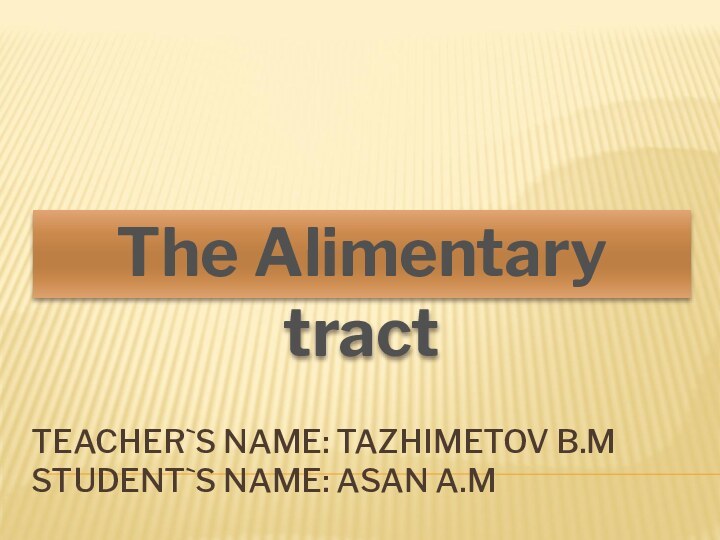
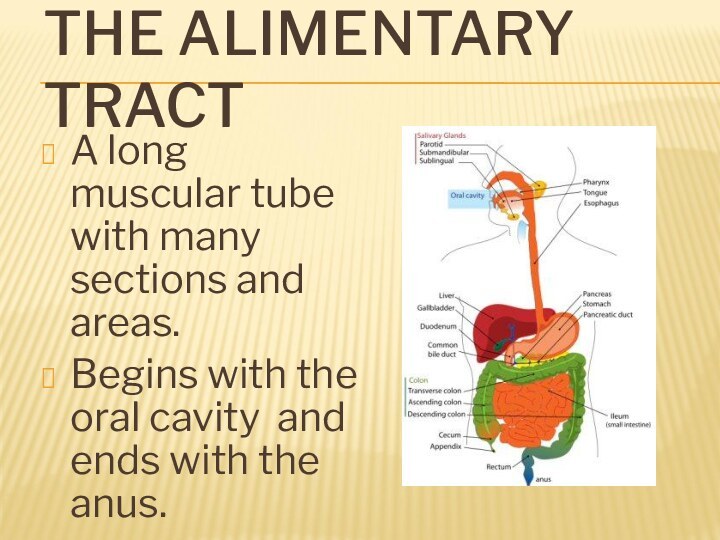
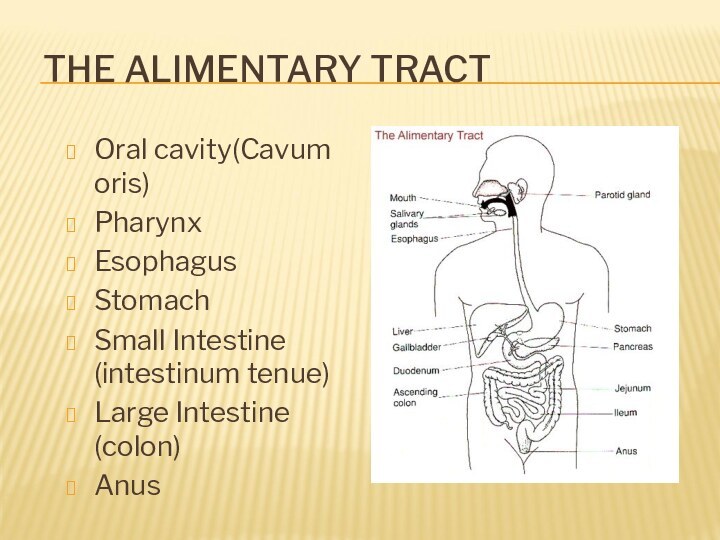
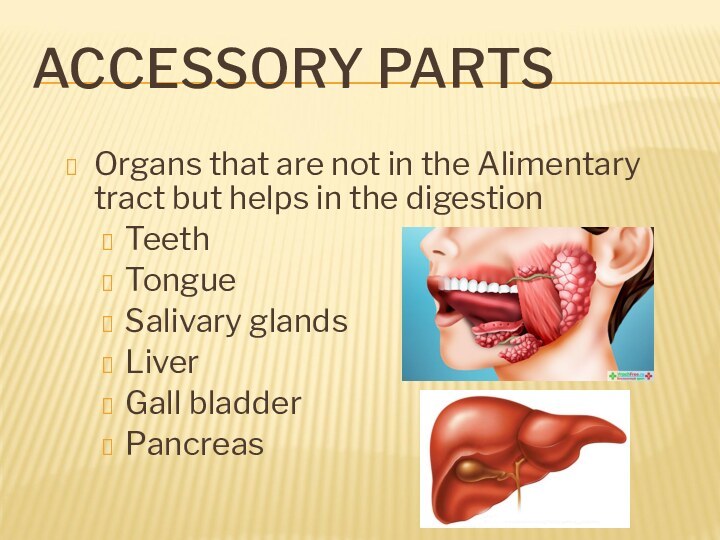
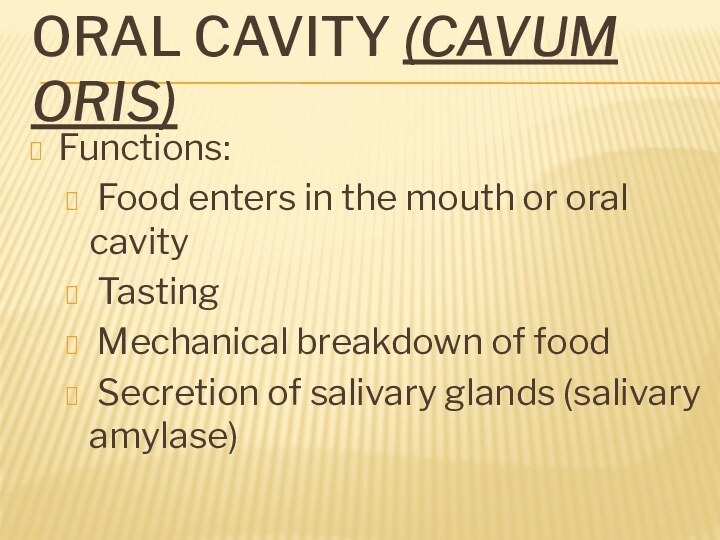

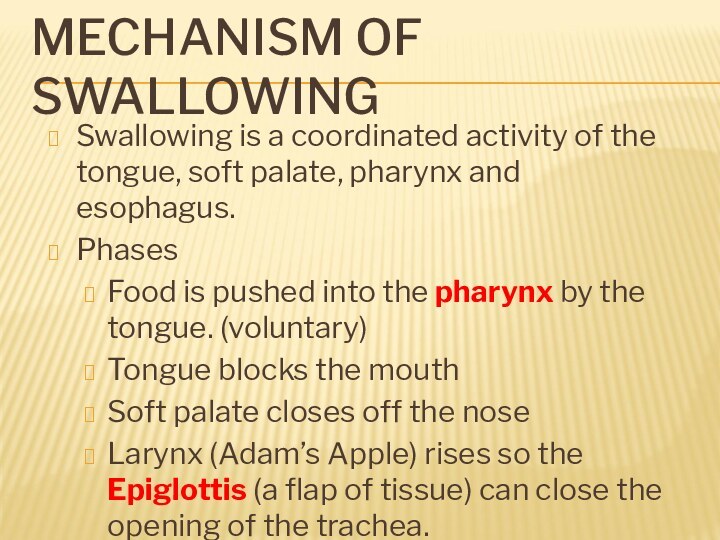
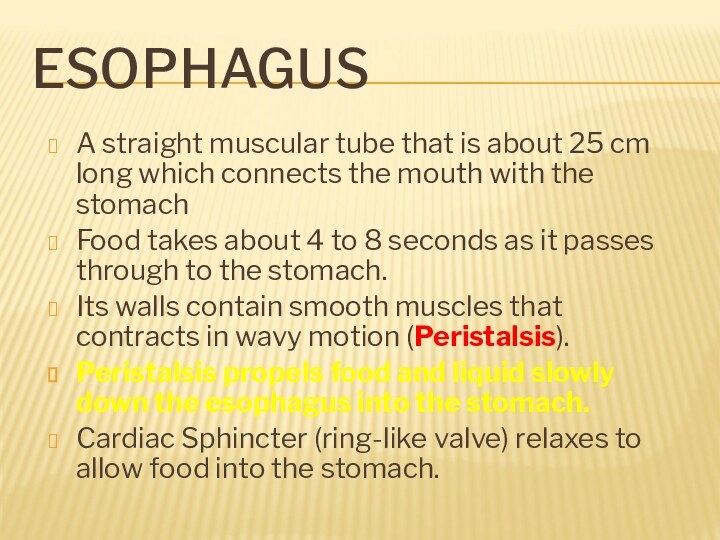
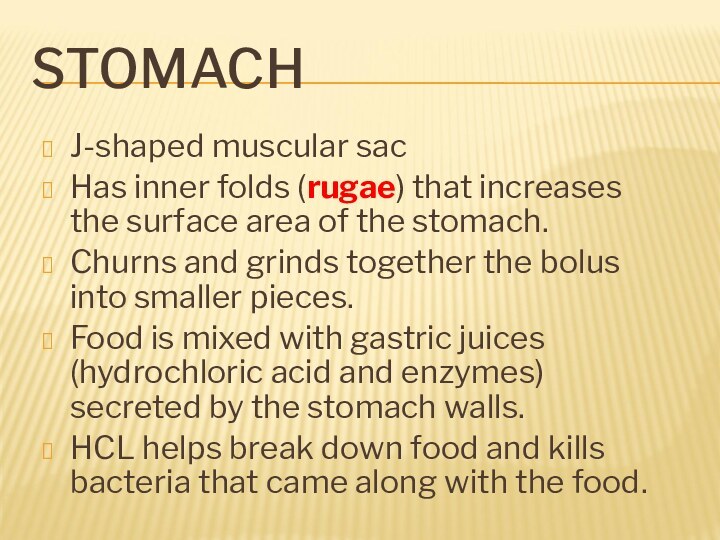
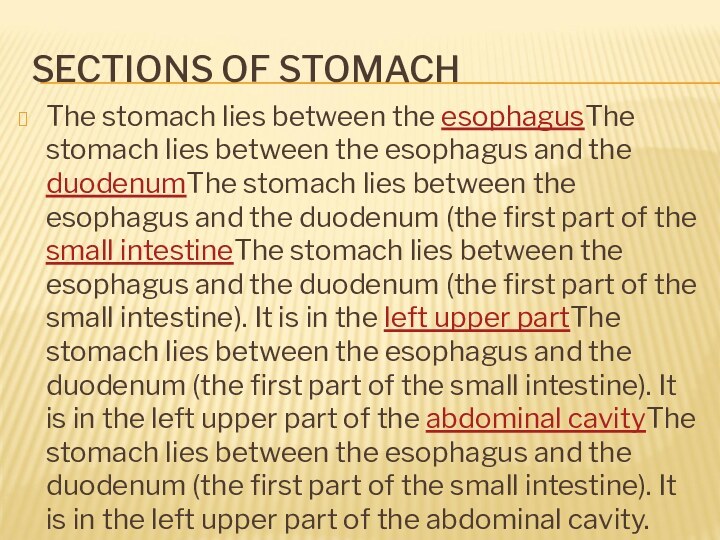
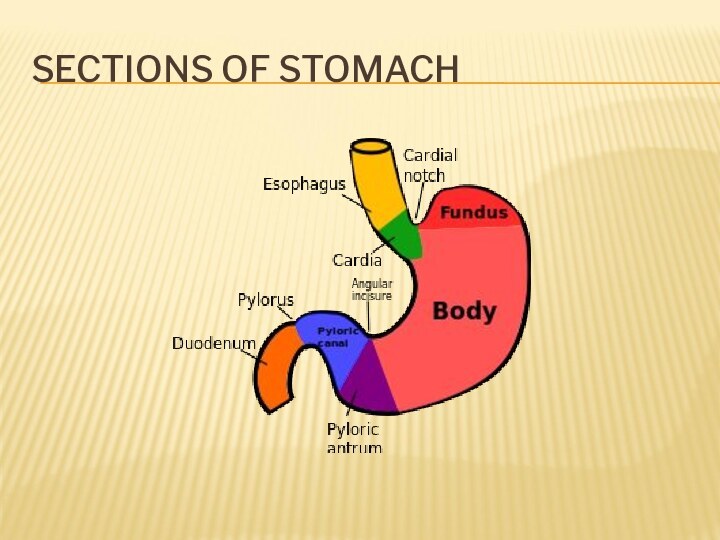
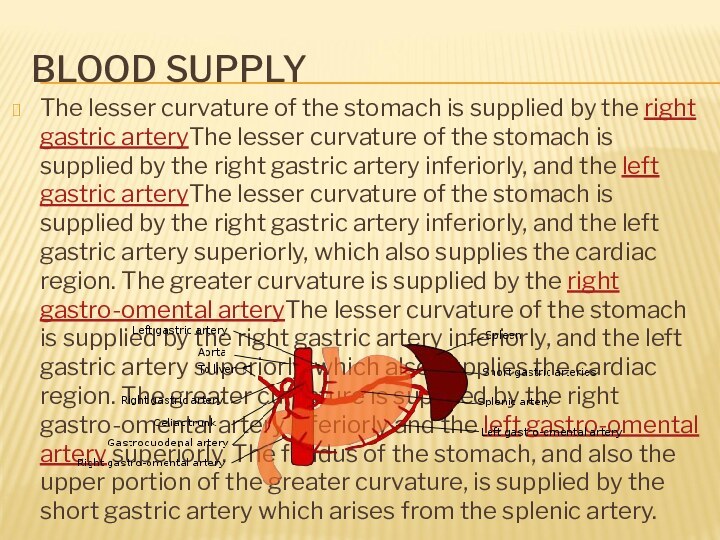
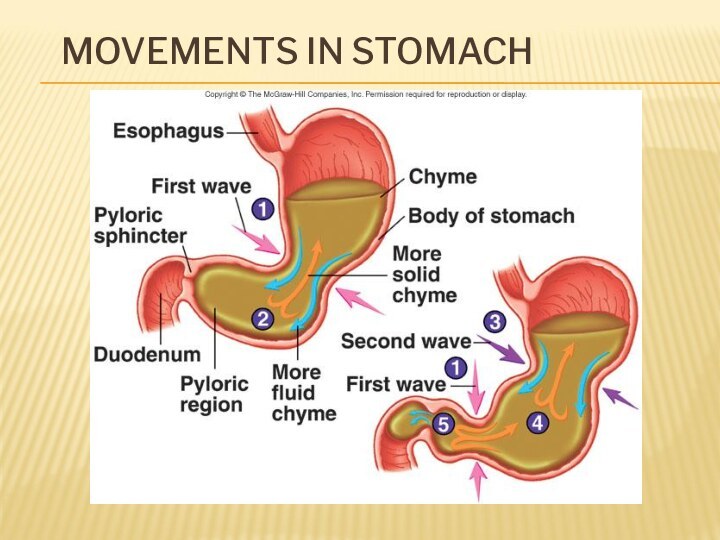
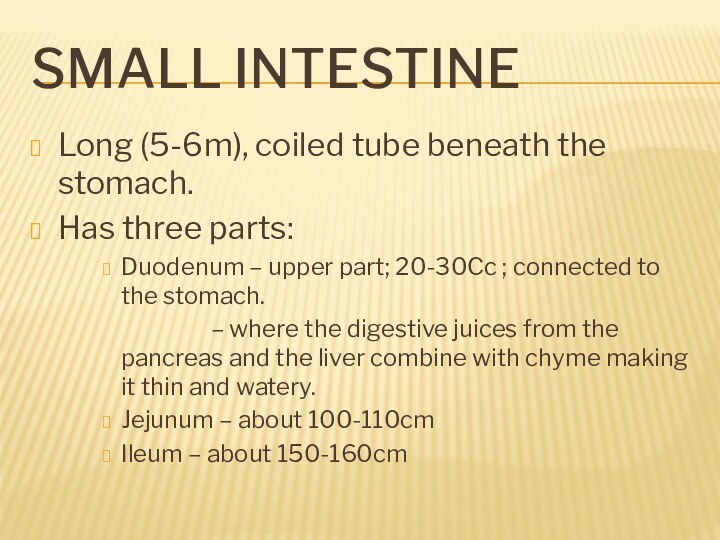
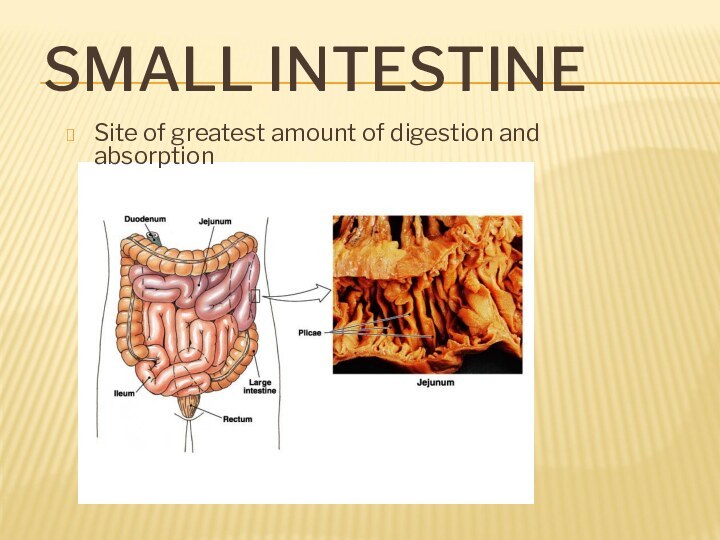

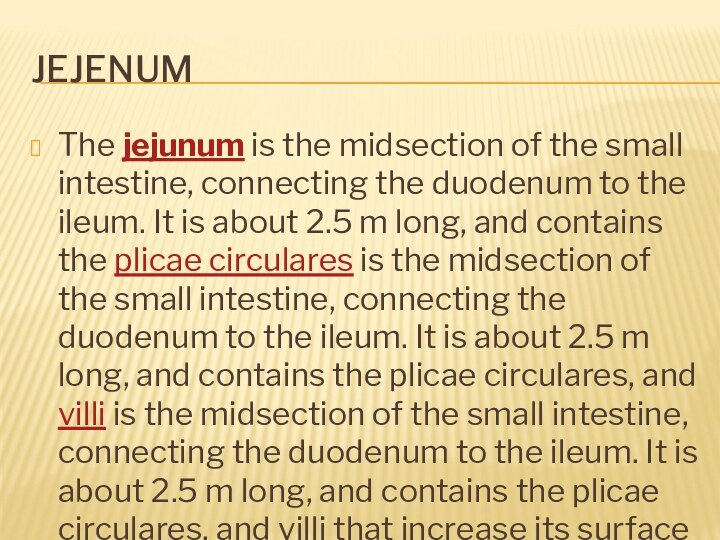
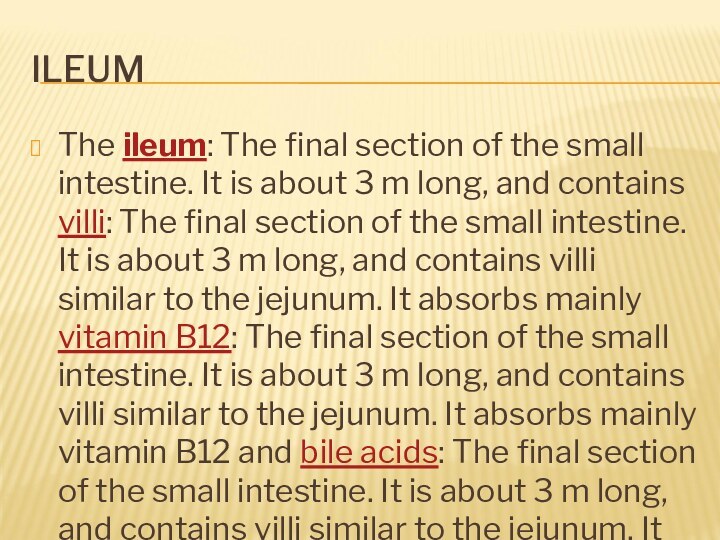
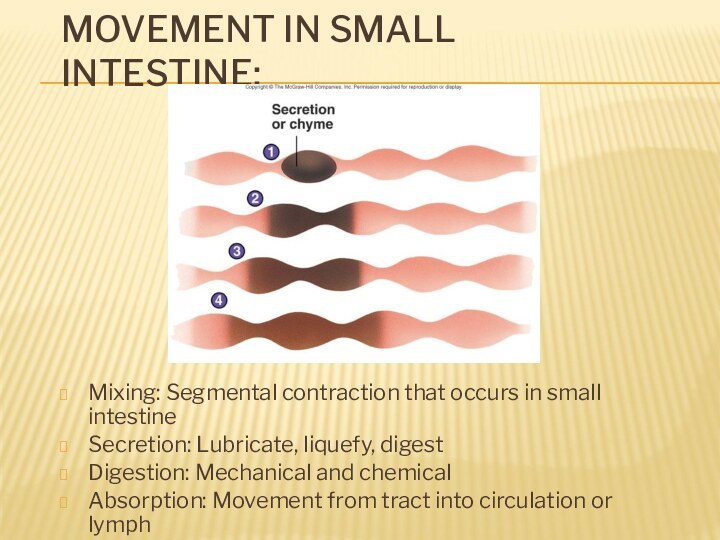
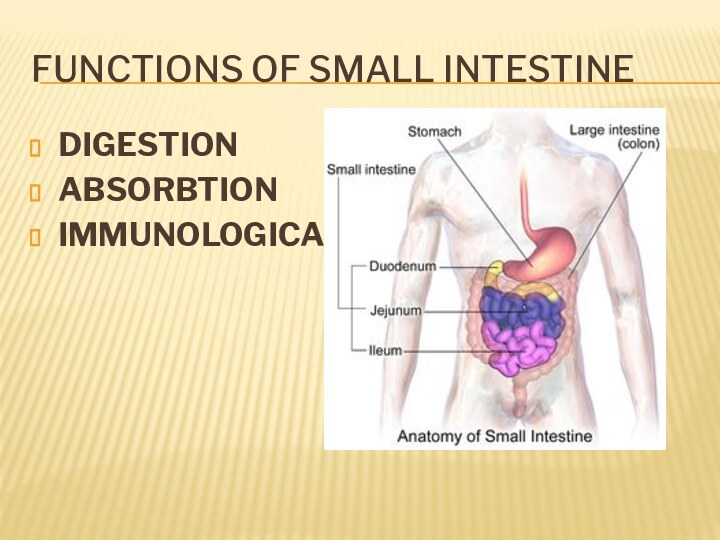
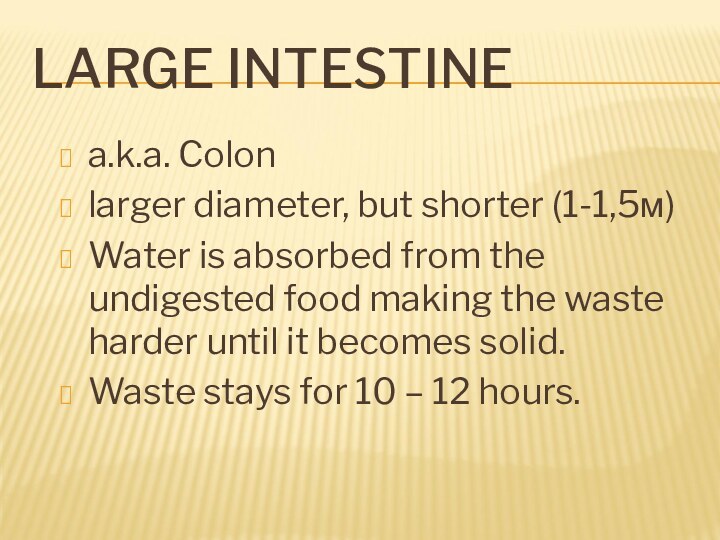

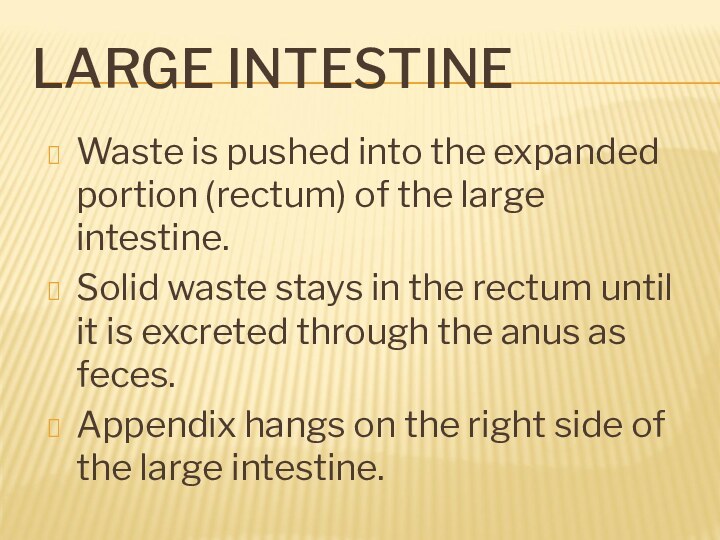
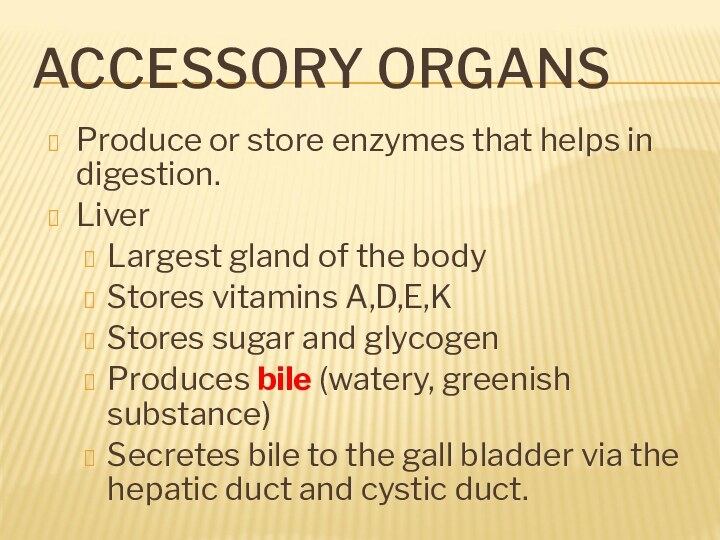
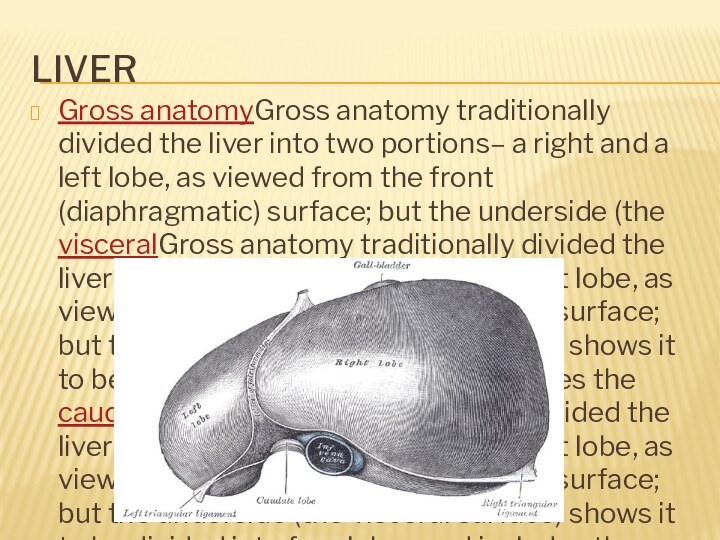
Слайд 3
THE ALIMENTARY TRACT
Oral cavity(Cavum oris)
Pharynx
Esophagus
Stomach
Small Intestine (intestinum
tenue)
Large Intestine (colon)
Anus
Слайд 4
ACCESSORY PARTS
Organs that are not in the Alimentary
tract but helps in the digestion
Teeth
Tongue
Salivary glands
Liver
Gall
bladderPancreas
Слайд 5
ORAL CAVITY (CAVUM ORIS)
Functions:
Food enters in the
mouth or oral cavity
Tasting
Mechanical breakdown of food
Secretion of salivary glands (salivary amylase)
Слайд 6
MOUTH
Structures in the mouth that aids digestion:
Teeth
– cut, tear, crush and grind food.
Salivary glands
– produce and secrete saliva into the oral cavity. Parotid (beneath the cheeks)
Submaxillary (below the jaw bone)
Sublingual (below the tongue)
Слайд 7
MECHANISM OF SWALLOWING
Swallowing is a coordinated activity of
the tongue, soft palate, pharynx and esophagus.
Phases
Food is pushed
into the pharynx by the tongue. (voluntary) Tongue blocks the mouth
Soft palate closes off the nose
Larynx (Adam’s Apple) rises so the Epiglottis (a flap of tissue) can close the opening of the trachea.
Слайд 8
ESOPHAGUS
A straight muscular tube that is about 25
cm long which connects the mouth with the stomach
Food
takes about 4 to 8 seconds as it passes through to the stomach.Its walls contain smooth muscles that contracts in wavy motion (Peristalsis).
Peristalsis propels food and liquid slowly down the esophagus into the stomach.
Cardiac Sphincter (ring-like valve) relaxes to allow food into the stomach.
Слайд 9
STOMACH
J-shaped muscular sac
Has inner folds (rugae) that increases
the surface area of the stomach.
Churns and grinds together
the bolus into smaller pieces.Food is mixed with gastric juices (hydrochloric acid and enzymes) secreted by the stomach walls.
HCL helps break down food and kills bacteria that came along with the food.
Слайд 10
SECTIONS OF STOMACH
The stomach lies between the esophagusThe
stomach lies between the esophagus and the duodenumThe stomach
lies between the esophagus and the duodenum (the first part of the small intestineThe stomach lies between the esophagus and the duodenum (the first part of the small intestine). It is in the left upper partThe stomach lies between the esophagus and the duodenum (the first part of the small intestine). It is in the left upper part of the abdominal cavityThe stomach lies between the esophagus and the duodenum (the first part of the small intestine). It is in the left upper part of the abdominal cavity. The top of the stomach lies against the diaphragmThe stomach lies between the esophagus and the duodenum (the first part of the small intestine). It is in the left upper part of the abdominal cavity. The top of the stomach lies against the diaphragm. Lying behind the stomach is the pancreasThe stomach lies between the esophagus and the duodenum (the first part of the small intestine). It is in the left upper part of the abdominal cavity. The top of the stomach lies against the diaphragm. Lying behind the stomach is the pancreas. A large double fold of visceral peritoneumThe stomach lies between the esophagus and the duodenum (the first part of the small intestine). It is in the left upper part of the abdominal cavity. The top of the stomach lies against the diaphragm. Lying behind the stomach is the pancreas. A large double fold of visceral peritoneum called the greater omentumThe stomach lies between the esophagus and the duodenum (the first part of the small intestine). It is in the left upper part of the abdominal cavity. The top of the stomach lies against the diaphragm. Lying behind the stomach is the pancreas. A large double fold of visceral peritoneum called the greater omentum hangs down from the greater curvature of the stomach.Two sphincters keep the contents of the stomach contained; the lower esophageal sphincterTwo sphincters keep the contents of the stomach contained; the lower esophageal sphincter (found in the cardiac region), at the junction of the oesophagus and stomach, and the pyloric sphincter at the junction of the stomach with the duodenum.
Слайд 12
BLOOD SUPPLY
The lesser curvature of the stomach is
supplied by the right gastric arteryThe lesser curvature of
the stomach is supplied by the right gastric artery inferiorly, and the left gastric arteryThe lesser curvature of the stomach is supplied by the right gastric artery inferiorly, and the left gastric artery superiorly, which also supplies the cardiac region. The greater curvature is supplied by the right gastro-omental arteryThe lesser curvature of the stomach is supplied by the right gastric artery inferiorly, and the left gastric artery superiorly, which also supplies the cardiac region. The greater curvature is supplied by the right gastro-omental artery inferiorly and the left gastro-omental artery superiorly. The fundus of the stomach, and also the upper portion of the greater curvature, is supplied by the short gastric artery which arises from the splenic artery.
Слайд 14
SMALL INTESTINE
Long (5-6m), coiled tube beneath the stomach.
Has
three parts:
Duodenum – upper part; 20-30Cc ; connected to
the stomach.– where the digestive juices from the pancreas and the liver combine with chyme making it thin and watery.
Jejunum – about 100-110cm
Ileum – about 150-160cm
Слайд 16
DUODENUM
The duodenum is a short structure (about 20–25 cm
long) continuous with the stomach and shaped like a
"C".[7] It surrounds the head of the pancreas. It receives gastric chyme It surrounds the head of the pancreas. It receives gastric chyme from the stomach, together with digestive juices from the pancreas It surrounds the head of the pancreas. It receives gastric chyme from the stomach, together with digestive juices from the pancreas (digestive enzymes It surrounds the head of the pancreas. It receives gastric chyme from the stomach, together with digestive juices from the pancreas (digestive enzymes) and the gall bladder It surrounds the head of the pancreas. It receives gastric chyme from the stomach, together with digestive juices from the pancreas (digestive enzymes) and the gall bladder (bile It surrounds the head of the pancreas. It receives gastric chyme from the stomach, together with digestive juices from the pancreas (digestive enzymes) and the gall bladder (bile). The digestive enzymes break down proteins and bile and emulsify It surrounds the head of the pancreas. It receives gastric chyme from the stomach, together with digestive juices from the pancreas (digestive enzymes) and the gall bladder (bile). The digestive enzymes break down proteins and bile and emulsify fats into micelles It surrounds the head of the pancreas. It receives gastric chyme from the stomach, together with digestive juices from the pancreas (digestive enzymes) and the gall bladder (bile). The digestive enzymes break down proteins and bile and emulsify fats into micelles. The duodenum It surrounds the head of the pancreas. It receives gastric chyme from the stomach, together with digestive juices from the pancreas (digestive enzymes) and the gall bladder (bile). The digestive enzymes break down proteins and bile and emulsify fats into micelles. The duodenum contains Brunner's glands It surrounds the head of the pancreas. It receives gastric chyme from the stomach, together with digestive juices from the pancreas (digestive enzymes) and the gall bladder (bile). The digestive enzymes break down proteins and bile and emulsify fats into micelles. The duodenum contains Brunner's glands, which produce a mucus-rich alkaline secretion containing bicarbonate. These secretions, in combination with bicarbonate from the pancreas, neutralizes the stomach acids contained in gastric chyme.
Слайд 17
JEJENUM
The jejunum is the midsection of the small
intestine, connecting the duodenum to the ileum. It is
about 2.5 m long, and contains the plicae circulares is the midsection of the small intestine, connecting the duodenum to the ileum. It is about 2.5 m long, and contains the plicae circulares, and villi is the midsection of the small intestine, connecting the duodenum to the ileum. It is about 2.5 m long, and contains the plicae circulares, and villi that increase its surface area. Products of digestion (sugars, amino acids, and fatty acids) are absorbed into the bloodstream here. The suspensory muscle of duodenum marks the division between the duodenum and the jejunum.
Слайд 18
ILEUM
The ileum: The final section of the small
intestine. It is about 3 m long, and contains
villi: The final section of the small intestine. It is about 3 m long, and contains villi similar to the jejunum. It absorbs mainly vitamin B12: The final section of the small intestine. It is about 3 m long, and contains villi similar to the jejunum. It absorbs mainly vitamin B12 and bile acids: The final section of the small intestine. It is about 3 m long, and contains villi similar to the jejunum. It absorbs mainly vitamin B12 and bile acids, as well as any other remaining nutrients. The ileum joins to the cecum: The final section of the small intestine. It is about 3 m long, and contains villi similar to the jejunum. It absorbs mainly vitamin B12 and bile acids, as well as any other remaining nutrients. The ileum joins to the cecum of the large intestine: The final section of the small intestine. It is about 3 m long, and contains villi similar to the jejunum. It absorbs mainly vitamin B12 and bile acids, as well as any other remaining nutrients. The ileum joins to the cecum of the large intestine at the ileocecal junction.
Слайд 19
MOVEMENT IN SMALL INTESTINE:
Mixing: Segmental contraction that occurs
in small intestine
Secretion: Lubricate, liquefy, digest
Digestion: Mechanical and chemical
Absorption:
Movement from tract into circulation or lymphElimination: Waste products removed from body
Слайд 21
LARGE INTESTINE
a.k.a. Colon
larger diameter, but shorter (1-1,5м)
Water is
absorbed from the undigested food making the waste harder
until it becomes solid.Waste stays for 10 – 12 hours.
Слайд 23
LARGE INTESTINE
Waste is pushed into the expanded portion
(rectum) of the large intestine.
Solid waste stays in the
rectum until it is excreted through the anus as feces.Appendix hangs on the right side of the large intestine.
Слайд 24
ACCESSORY ORGANS
Produce or store enzymes that helps in
digestion.
Liver
Largest gland of the body
Stores vitamins A,D,E,K
Stores sugar and glycogen
Produces bile (watery, greenish substance)
Secretes bile to the gall bladder via the hepatic duct and cystic duct.


